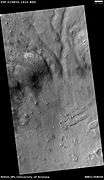Nereidum Montes
.jpg) Computer-generated perspective view of Nereidum Montes from the High-Resolution Stereo Camera (HRSC) on ESA’s Mars Express. | |
| Location | Argyre quadrangle |
|---|---|
| Coordinates | 37°34′S 43°13′W / 37.57°S 43.21°WCoordinates: 37°34′S 43°13′W / 37.57°S 43.21°W |
| Length | 3,677 km |
| Eponym | Classical albedo feature |
The Nereidum Montes is a mountain range on Mars. It stretches 3,677 km, northeast of Argyre Planitia. It is in the Argyre quadrangle. The mountains are named after a Classical albedo feature.
There is a crater at 45.1°S, 55.0°W on the Nereidum Montes that is similar to Galle in that it also has a smiley face pattern on the crater. However, it is much smaller than Galle itself.
A hummocky relief resembling Veiki moraines has been found in Nereidum Montes. The relief is hypothesized to result very much like Veiki moraines from the melting of a martian glacier.[1]
Gullies
Gullies are common in some latitude bands on Mars. Usually, gullies are found on the walls of craters or troughs, but Nereidum Montes has gullies in some areas. See the image below. Gullies occur on steep slopes, especially craters. Gullies are believed to be relatively young because they have few, if any craters, and they lie on top of sand dunes which are young. Usually, each gully has an alcove, channel, and apron. Although many ideas have been put forward to explain them, the most popular involve liquid water either coming from an aquifer or left over from old glaciers.[2]
For years, many believed that gullies were formed by running water, but further observations demonstrate that they may be formed by dry ice. Recent studies describe using the High Resolution Imaging Science Experiment (HiRISE) camera on MRO to examine gullies at 356 sites, starting in 2006. Thirty-eight of the sites showed active gully formation. Before-and-after images demonstrated the timing of this activity coincided with seasonal carbon dioxide frost and temperatures that would not have allowed for liquid water. When dry ice frost changes to a gas, it may lubricate dry material to flow especially on steep slopes.[3][4][5] In some years frost, perhaps as thick as 1 meter, triggers avalanches. This frost contains mostly dry ice, but also has tiny amounts of water ice.[6]
- Gullies on a massif in the Nereidum Montes, as seen by Mars Reconnaissance Orbiter's CTX.
 Surface in Argyre quadrangle as seen by HiRISE, under the HiWish program. Image is located in Nereidum Montes. This is the image of the surface from a single HiRISE image. The scale bar at the top is 500 meters long.
Surface in Argyre quadrangle as seen by HiRISE, under the HiWish program. Image is located in Nereidum Montes. This is the image of the surface from a single HiRISE image. The scale bar at the top is 500 meters long.- CTX image showing context for the next image. A group of channels are visible in this image. Image is located in Nereidum Montes.
- Close-up of surface in Argyre quadrangle, as seen by HiRISE, under the HiWish program. Image is located in Nereidum Montes.
 Gullies in Nereidum Montes, as seen by HiRISE under HiWish program.
Gullies in Nereidum Montes, as seen by HiRISE under HiWish program. Layers exposed in Nereidum Montes, as seen by HiRISE under HiWish program The light-toned layers may contain sulfates which are good for preserving traces of ancient life.
Layers exposed in Nereidum Montes, as seen by HiRISE under HiWish program The light-toned layers may contain sulfates which are good for preserving traces of ancient life.
References
- ↑ Johnsson, A.; Reiss, D.; Hauber, E.; Johnson, M.D.; Olvmo, M.; Hiesinger, H. (2016). Veiki-moraine-like Landforms in the Nereidum Montes Region on Mars: Insights from Analogues in Northern Sweden (PDF). 47th Lunar and Planetary Science Conference.
- ↑ Heldmann, J. and M. Mellon. Observations of martian gullies and constraints on potential formation mechanisms. 2004. Icarus. 168: 285-304.
- ↑ http://www.jpl.nasa.gov/news/news.php?release=2014-226
- ↑ http://hirise.lpl.arizona.edu/ESP_032078_1420
- ↑ http://www.space.com/26534-mars-gullies-dry-ice.html
- ↑ http://spaceref.com/mars/frosty-gullies-on-mars.html
See also
External links
- "Nereidum Montes". Gazetteer of Planetary Nomenclature. USGS Astrogeology Research Program.
